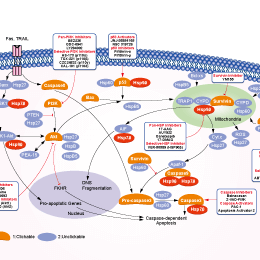
- 阻害剤
- 研究分野別
- PI3K/Akt/mTOR
- Epigenetics
- Methylation
- Immunology & Inflammation
- Protein Tyrosine Kinase
- Angiogenesis
- Apoptosis
- Autophagy
- ER stress & UPR
- JAK/STAT
- MAPK
- Cytoskeletal Signaling
- Cell Cycle
- TGF-beta/Smad
- 化合物ライブラリー
- Popular Compound Libraries
- Customize Library
- Clinical and FDA-approved Related
- Bioactive Compound Libraries
- Inhibitor Related
- Natural Product Related
- Metabolism Related
- Cell Death Related
- By Signaling Pathway
- By Disease
- Anti-infection and Antiviral Related
- Neuronal and Immunology Related
- Fragment and Covalent Related
- FDA-approved Drug Library
- FDA-approved & Passed Phase I Drug Library
- Preclinical/Clinical Compound Library
- Bioactive Compound Library-I
- Bioactive Compound Library-II
- Kinase Inhibitor Library
- Express-Pick Library
- Natural Product Library
- Human Endogenous Metabolite Compound Library
- Alkaloid Compound LibraryNew
- Angiogenesis Related compound Library
- Anti-Aging Compound Library
- Anti-alzheimer Disease Compound Library
- Antibiotics compound Library
- Anti-cancer Compound Library
- Anti-cancer Compound Library-Ⅱ
- Anti-cancer Metabolism Compound Library
- Anti-Cardiovascular Disease Compound Library
- Anti-diabetic Compound Library
- Anti-infection Compound Library
- Antioxidant Compound Library
- Anti-parasitic Compound Library
- Antiviral Compound Library
- Apoptosis Compound Library
- Autophagy Compound Library
- Calcium Channel Blocker LibraryNew
- Cambridge Cancer Compound Library
- Carbohydrate Metabolism Compound LibraryNew
- Cell Cycle compound library
- CNS-Penetrant Compound Library
- Covalent Inhibitor Library
- Cytokine Inhibitor LibraryNew
- Cytoskeletal Signaling Pathway Compound Library
- DNA Damage/DNA Repair compound Library
- Drug-like Compound Library
- Endoplasmic Reticulum Stress Compound Library
- Epigenetics Compound Library
- Exosome Secretion Related Compound LibraryNew
- FDA-approved Anticancer Drug LibraryNew
- Ferroptosis Compound Library
- Flavonoid Compound Library
- Fragment Library
- Glutamine Metabolism Compound Library
- Glycolysis Compound Library
- GPCR Compound Library
- Gut Microbial Metabolite Library
- HIF-1 Signaling Pathway Compound Library
- Highly Selective Inhibitor Library
- Histone modification compound library
- HTS Library for Drug Discovery
- Human Hormone Related Compound LibraryNew
- Human Transcription Factor Compound LibraryNew
- Immunology/Inflammation Compound Library
- Inhibitor Library
- Ion Channel Ligand Library
- JAK/STAT compound library
- Lipid Metabolism Compound LibraryNew
- Macrocyclic Compound Library
- MAPK Inhibitor Library
- Medicine Food Homology Compound Library
- Metabolism Compound Library
- Methylation Compound Library
- Mouse Metabolite Compound LibraryNew
- Natural Organic Compound Library
- Neuronal Signaling Compound Library
- NF-κB Signaling Compound Library
- Nucleoside Analogue Library
- Obesity Compound Library
- Oxidative Stress Compound LibraryNew
- Phenotypic Screening Library
- PI3K/Akt Inhibitor Library
- Protease Inhibitor Library
- Protein-protein Interaction Inhibitor Library
- Pyroptosis Compound Library
- Small Molecule Immuno-Oncology Compound Library
- Mitochondria-Targeted Compound LibraryNew
- Stem Cell Differentiation Compound LibraryNew
- Stem Cell Signaling Compound Library
- Natural Phenol Compound LibraryNew
- Natural Terpenoid Compound LibraryNew
- TGF-beta/Smad compound library
- Traditional Chinese Medicine Library
- Tyrosine Kinase Inhibitor Library
- Ubiquitination Compound Library
-
Cherry Picking
You can personalize your library with chemicals from within Selleck's inventory. Build the right library for your research endeavors by choosing from compounds in all of our available libraries.
Please contact us at info@selleck.co.jp to customize your library.
You could select:
- FDA-approved Drug Library
- FDA-approved & Passed Phase I Drug Library
- Preclinical/Clinical Compound Library
- Bioactive Compound Library-I
- Bioactive Compound Library-II
- Kinase Inhibitor Library
- Express-Pick Library
- Natural Product Library
- Human Endogenous Metabolite Compound Library
- Covalent Inhibitor Library
- FDA-approved Anticancer Drug LibraryNew
- Highly Selective Inhibitor Library
- HTS Library for Drug Discovery
- Metabolism Compound Library
- 抗体
- 新製品
- お問い合わせ
Tanespimycin (17-AAG)
別名:CP127374, NSC-330507, KOS 953
Tanespimycin (17-AAG, CP127374, NSC-330507, KOS 953) is a potent HSP90 inhibitor with IC50 of 5 nM in a cell-free assay, having a 100-fold higher binding affinity for HSP90 derived from tumour cells than HSP90 from normal cells. Tanespimycin (17-AAG) induces apoptosis, necrosis, autophagy and mitophagy. Phase 3.
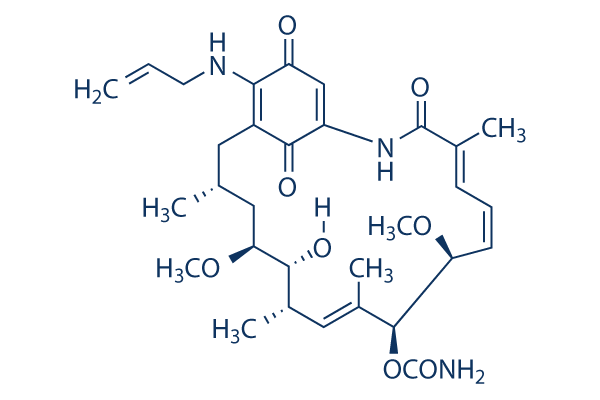
CAS No. 75747-14-7
文献中Selleckの製品使用例(142)
製品安全説明書
現在のバッチを見る:
純度:
99.92%
99.92
Tanespimycin (17-AAG)関連製品
シグナル伝達経路
HSP (HSP90)阻害剤の選択性比較
Cell Data
| Cell Lines | Assay Type | Concentration | Incubation Time | 活性情報 | PMID |
|---|---|---|---|---|---|
| C2BBe1 | Growth Inhibition Assay | IC50=0.2219 μM | SANGER | ||
| TE-9 | Growth Inhibition Assay | IC50=0.21786 μM | SANGER | ||
| MFE-280 | Growth Inhibition Assay | IC50=0.21298 μM | SANGER | ||
| 他の多くの細胞株試験データをご覧になる場合はこちらをクリックして下さい | |||||
生物活性
| 製品説明 | Tanespimycin (17-AAG, CP127374, NSC-330507, KOS 953) is a potent HSP90 inhibitor with IC50 of 5 nM in a cell-free assay, having a 100-fold higher binding affinity for HSP90 derived from tumour cells than HSP90 from normal cells. Tanespimycin (17-AAG) induces apoptosis, necrosis, autophagy and mitophagy. Phase 3. | ||
|---|---|---|---|
| 特性 | Displays very low toxicity toward normal cells. | ||
| Targets |
|
| In Vitro | ||||
| In vitro |
17-AAG, an analog of geldanamycin, exhibits greater than 100 times higher binding affinity for Hsp90 derived from HER-2-overexpressing cancer cells (BT474, N87, SKOV3 and SKBR3) or BT474 breast carcinoma cells with IC50 values of 5-6 nM. [1] 17-AAG causes the degradation of HER2, HER3, Akt, and both mutant and wild-type androgen receptor (AR), leading to the RB-dependent G1 growth arrest of prostate cancer cells such as LNCaP, LAPC-4, DU-145, and PC-3 with IC50 values of 25-45 nM. [2] In addition to inducing apoptosis of Ba/F3 cells transformed with wild-type BCR-ABL with an IC50 of 5.2 μM, 17-AAG has the ability to induce apoptosis of cells transformed with T315I and E255K BCR-ABL mutants with IC50 values of 2.3 μM and 1.0 μM, respectively, by inducing the degradation of both wild-type BCR-ABL protein and mutants. [3] |
|||
|---|---|---|---|---|
| Kinase Assay | Hsp90 binding assays | |||
| Purified native Hsp90 protein or cell lysates from HER-2-overexpressing cancer cells (BT474, N87, SKOV3 and SKBR3) or BT474 breast carcinoma cells in lysis buffer (20 mM HEPES, pH 7.3, 1 mM EDTA, 5 mM MgCl2, 100 mM KCl) are incubated with various concentrations of 17-AAG for 30 minutes at 4 °C, and then incubated with biotin-GM linked to BioMag streptavidin magnetic beads for 1 hour at 4 °C. Tubes are placed on a magnetic rack, and the unbound supernatant removed. The magnetic beads are washed three times in lysis buffer and heated for 5 minutes at 95 °C in SDS–PAGE sample buffer. Samples are analysed on SDS protein gels, and western blots done using indicated antibodies. Bands in the western blots are quantified using the Bio-rad Fluor-S MultiImager, and the percentage inhibition of binding of Hsp90 to the biotin-GM is calculated. The IC50 reported is the concentration of 17-AAG needed to cause half-maximal inhibition of binding. | ||||
| 細胞実験 | 細胞株 | BT474, SKBR3, N87, SKOV3, MCF7, MDA468, Hs578T, Hs578Bst, A549, HT29, U87, SKMG3, HT1080, RPTEC, NDF, HMVEC, HMEC, HUVEC, and PBMC cells | ||
| 濃度 | Dissolved in DMSO, final concentrations ~10 μM | |||
| 反応時間 | 5 days | |||
| 実験の流れ | Cells are seeded in 96-well plates at 2,000 cells per well in a final culture volume of 100 μL for 24 hours before the addition of increasing concentrations of 17-AAG that is incubated for 5 days. Viable cell number is determined using the Celltiter 96 AQueous Nonradioactive Cell Proliferation Assay. The value of the background absorbance at 490 nm (A490) of wells not containing cells is subtracted. Percentage of viable cells = (A490 of 17-AAG treated sample/A490 untreated cells) × 100. The IC50 is defined as the concentration that gave rise to 50% viable cell number. |
|||
| 実験結果図 | Methods | Biomarkers | 結果図 | PMID |
| Western blot | α-Synuclein / HSP90 / HSP70 / HSP32 / αB-Crystallin EGFR / PDGFR / AKT / MAPK / c-RAS pAKT / pMAPK / pRb Cleaved PARP / Survivin LATS1 / p-LATS1 / YAP / CTGF |
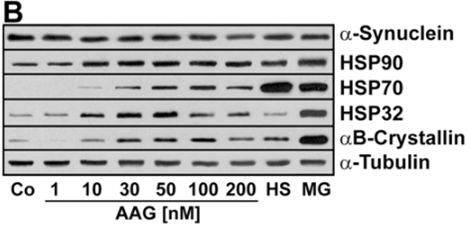
|
20090920 | |
| Immunofluorescence | STAT3 YAP / TAZ β-catenin / E-cadherin |
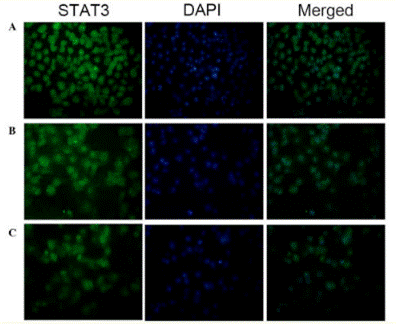
|
27279418 | |
| Growth inhibition assay | Cell viability |
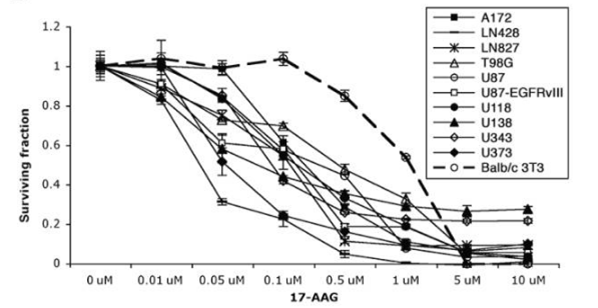
|
18682579 | |
| In Vivo | ||
| In Vivo |
17-AAG displays significantly higher binding affinity for Hsp90 from 3T3-src, B16 or CT26 xenografts in nude mice with IC50 values of 8-35 nM as compared with that from the normal tissues with IC50 values of 200-600 nM. [1] Administration of 17-AAG (~50 mg/kg) causes significant decline in AR, HER2, HER3, and Akt expression in a dose-dependent manner with >50% decline at dose of 50 mg/kg, resulting in the dose-dependent inhibition of androgen-dependent (CWR22) and -independent (CWR22R and CWRSA6) prostate cancer xenografts growth by 67%, 80% and 68% at dose of 50 mg/kg, respectively. [2] |
|
|---|---|---|
| 動物実験 | 動物モデル | Male nu/nu athymic mice inoculated s.c. with androgen-dependent CWR22 xenograft, and female nu/nu athymic mice inoculated s.c. with androgen-independent xenografts CWR22R and CWRSA6 |
| 投与量 | ~50 mg/kg | |
| 投与経路 | Injection i.p. | |
| NCT Number | Recruitment | Conditions | Sponsor/Collaborators | Start Date | Phases |
|---|---|---|---|---|---|
| NCT00103272 | Terminated | Adult Acute Basophilic Leukemia|Adult Acute Eosinophilic Leukemia|Adult Acute Megakaryoblastic Leukemia (M7)|Adult Acute Minimally Differentiated Myeloid Leukemia (M0)|Adult Acute Monoblastic Leukemia (M5a)|Adult Acute Monocytic Leukemia (M5b)|Adult Acute Myeloblastic Leukemia With Maturation (M2)|Adult Acute Myeloblastic Leukemia Without Maturation (M1)|Adult Acute Myeloid Leukemia With 11q23 (MLL) Abnormalities|Adult Acute Myeloid Leukemia With Inv(16)(p13;q22)|Adult Acute Myeloid Leukemia With t(16;16)(p13;q22)|Adult Acute Myeloid Leukemia With t(8;21)(q22;q22)|Adult Acute Myelomonocytic Leukemia (M4)|Adult Erythroleukemia (M6a)|Adult Pure Erythroid Leukemia (M6b)|Anaplastic Large Cell Lymphoma|Angioimmunoblastic T-cell Lymphoma|Extranodal Marginal Zone B-cell Lymphoma of Mucosa-associated Lymphoid Tissue|Nodal Marginal Zone B-cell Lymphoma|Recurrent Adult Acute Lymphoblastic Leukemia|Recurrent Adult Acute Myeloid Leukemia|Recurrent Adult Diffuse Large Cell Lymphoma|Recurrent Adult T-cell Leukemia/Lymphoma|Recurrent Cutaneous T-cell Non-Hodgkin Lymphoma|Recurrent Grade 1 Follicular Lymphoma|Recurrent Grade 2 Follicular Lymphoma|Recurrent Grade 3 Follicular Lymphoma|Recurrent Mantle Cell Lymphoma|Recurrent Marginal Zone Lymphoma|Recurrent Mycosis Fungoides/Sezary Syndrome|Recurrent Small Lymphocytic Lymphoma|Refractory Chronic Lymphocytic Leukemia|Small Intestine Lymphoma|Splenic Marginal Zone Lymphoma|Waldenström Macroglobulinemia |
National Cancer Institute (NCI) |
April 2005 | Phase 1 |
| NCT00098488 | Terminated | B-cell Chronic Lymphocytic Leukemia|Prolymphocytic Leukemia|Refractory Chronic Lymphocytic Leukemia |
National Cancer Institute (NCI) |
April 2005 | Phase 1 |
| NCT00118248 | Completed | Recurrent Thyroid Cancer|Stage IV Follicular Thyroid Cancer|Stage IV Papillary Thyroid Cancer|Thyroid Gland Medullary Carcinoma |
National Cancer Institute (NCI) |
December 2004 | Phase 2 |
| NCT00098423 | Completed | Accelerated Phase Chronic Myelogenous Leukemia|Adult Acute Basophilic Leukemia|Adult Acute Eosinophilic Leukemia|Adult Acute Megakaryoblastic Leukemia (M7)|Adult Acute Minimally Differentiated Myeloid Leukemia (M0)|Adult Acute Monoblastic Leukemia (M5a)|Adult Acute Monocytic Leukemia (M5b)|Adult Acute Myeloblastic Leukemia With Maturation (M2)|Adult Acute Myeloblastic Leukemia Without Maturation (M1)|Adult Acute Myeloid Leukemia With 11q23 (MLL) Abnormalities|Adult Acute Myeloid Leukemia With Inv(16)(p13;q22)|Adult Acute Myeloid Leukemia With t(16;16)(p13;q22)|Adult Acute Myeloid Leukemia With t(8;21)(q22;q22)|Adult Acute Myelomonocytic Leukemia (M4)|Adult Erythroleukemia (M6a)|Adult Pure Erythroid Leukemia (M6b)|Blastic Phase Chronic Myelogenous Leukemia|Chronic Myelomonocytic Leukemia|de Novo Myelodysplastic Syndromes|Previously Treated Myelodysplastic Syndromes|Recurrent Adult Acute Lymphoblastic Leukemia|Recurrent Adult Acute Myeloid Leukemia|Refractory Anemia With Excess Blasts in Transformation|Relapsing Chronic Myelogenous Leukemia|Secondary Acute Myeloid Leukemia|Secondary Myelodysplastic Syndromes |
National Cancer Institute (NCI) |
November 2004 | Phase 1 |
化学情報
| 分子量 | 585.69 | 化学式 | C31H43N3O8 |
| CAS No. | 75747-14-7 | SDF | Download Tanespimycin (17-AAG) SDFをダウンロードする |
| Smiles | CC1CC(C(C(C=C(C(C(C=CC=C(C(=O)NC2=CC(=O)C(=C(C1)C2=O)NCC=C)C)OC)OC(=O)N)C)C)O)OC | ||
| 保管 | |||
|
In vitro |
DMSO : 100 mg/mL ( (170.73 mM); 吸湿したDMSOは溶解度を減少させます。新しいDMSOをご使用ください。) Ethanol : 33 mg/mL Water : Insoluble |
モル濃度計算器 |
|
in vivo Add solvents to the product individually and in order. |
投与溶液組成計算機 | ||||
| Clear solution |
5%DMSO
Corn oil
|
10.0mg/ml (17.07mM) | Taking the 1 mL working solution as an example, add 50 μL of 200 mg/ml clear DMSO stock solution to 950 μL of corn oil and mix evenly. The mixed solution should be used immediately for optimal results. | ||
| Clear solution |
5%DMSO
40%
5%
50%ddH2O
|
6.0mg/ml (10.24mM) | Taking the 1 mL working solution as an example, add 50 μL of 120 mg/ml clarified DMSO stock solution to 400 μL of PEG300, mix evenly to clarify it; add 50 μL of Tween80 to the above system, mix evenly to clarify; then continue to add 500 μL of ddH2O to adjust the volume to 1 mL. The mixed solution should be used immediately for optimal results. | ||
実験計算
投与溶液組成計算機(クリア溶液)
ステップ1:実験データを入力してください。(実験操作によるロスを考慮し、動物数を1匹分多くして計算・調製することを推奨します)
mg/kg
g
μL
匹
ステップ2:投与溶媒の組成を入力してください。(ロット毎に適した溶解組成が異なる場合があります。詳細については弊社までお問い合わせください)
% DMSO
%
% Tween 80
% ddH2O
%DMSO
%
計算結果:
投与溶媒濃度: mg/ml;
DMSOストック溶液調製方法: mg 試薬を μL DMSOに溶解する(濃度 mg/mL, 注:濃度が当該ロットのDMSO溶解度を超える場合はご連絡ください。 )
投与溶媒調製方法:Take μL DMSOストック溶液に μL PEG300,を加え、完全溶解後μL Tween 80,を加えて完全溶解させた後 μL ddH2O,を加え完全に溶解させます。
投与溶媒調製方法:μL DMSOストック溶液に μL Corn oil,を加え、完全溶解。
注意:1.ストック溶液に沈殿、混濁などがないことをご確認ください;
2.順番通りに溶剤を加えてください。次のステップに進む前に溶液に沈殿、混濁などがないことを確認してから加えてください。ボルテックス、ソニケーション、水浴加熱など物理的な方法で溶解を早めることは可能です。
技術サポート
ストックの作り方、阻害剤の保管方法、細胞実験や動物実験の際に注意すべき点など、製品を取扱う時に問い合わせが多かった質問に対しては取扱説明書でお答えしています。
他に質問がある場合は、お気軽にお問い合わせください。
* 必須
よくある質問(FAQ)
質問1:
What kind of subtypes does this compound inhibit? HSP90α or HSP90β ?
回答
17-AAG can inhibit both HSP90α and HSP90β, but it is unclear how much are they affected respectively. You should note that Hsp90 derived from tumor cells has a 100-fold higher binding affinity for 17-AAG than that from normal cells according to this paper. http://www.nature.com.ezp-prod1.hul.harvard.edu/nature/journal/v425/n6956/full/nature01913.html
Tags: Tanespimycin (17-AAG)を買う | Tanespimycin (17-AAG) ic50 | Tanespimycin (17-AAG)供給者 | Tanespimycin (17-AAG)を購入する | Tanespimycin (17-AAG)費用 | Tanespimycin (17-AAG)生産者 | オーダーTanespimycin (17-AAG) | Tanespimycin (17-AAG)化学構造 | Tanespimycin (17-AAG)分子量 | Tanespimycin (17-AAG)代理店

